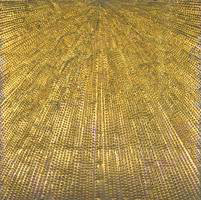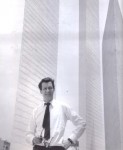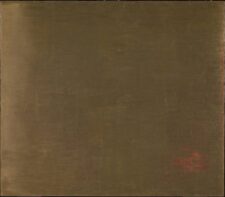
Mathias Goeritz
German, 1915-1990 (active Mexico)
Message, 1960s
wood, plaster, nails, paint, and iron
27 5/8 x 27 1/2 x 3 5/8 in.
SBMA, Gift of Robert B. and Mercedes H. Eichholz
1995.50.1

Goeritz in Mexico City, Queretaro Highway, The Towers of Satellite City (1957) designed by Luis BARRAGAN and Mathias GOERITZ.

Mathias Goeritz - Message, ca. 1959, gold leaf on plywood panel, Tate Art Museum, London
COMMENTS
"Message" c.1959 is a painting on wood panel in which overlapping areas of gold leaf have been applied over a dark red ground. It was commissioned by the Mexican lawyer Eduardo Prieto López for his house in El Pedregal, a suburb of Mexico City, designed and developed by architect Luis Barragán in the late 1940s and 1950s. Barragán designed the house and both Goeritz and the painter Jesús Reyes made a series of works for it; a testimony to the longstanding collaboration between Barragán, Goeritz and Reyes, all of whom were instrumental in the formation of Mexican modernism in art and architecture.
The painting belongs to a series of works known collectively as the Messages (in Spanish, Mensajes), which were produced by Goeritz after 1958 and informed by his concept of ‘emotional architecture’. Goeritz’s work was also shaped by his resistance to what he perceived as a general state of decadence in the art world at the time and his interest in religious art, something he was able to pursue in more depth after his arrival in Mexico from Europe in 1949. The series of Messages was also marked by personal tragedy (the death from cancer of his recently divorced wife Marianne Gast in 1958). Thus, Goeritz embarked on a series of paintings that returned to his interest in religious art, which he had made manifest in earlier works dealing with the theme of the cross and the divine hand. However, these later works pursued a different brand of mysticism, expressed by the artist in his manifesto ‘L’Art prière contre l’art merde’, which was published on the occasion of his exhibition at the Iris Clert Gallery in Paris in 1960. In it, he protests against individualism, materialism, intellectual egocentrism, rationalism, trends and the art world in general, proposing ‘l’art prière’ (prayer art) as the antidote to vanity and ambition. Goeritz defined ‘prayer art’ as an art of the ideal and the mystic, of love and belief, of form and color as expression of adoration, and of metaphysical and emotional experience.
Shown between 1960 and 1962 in different galleries (Galería de Arte Mexicano in Mexico City, Carstairs Gallery in New York and Iris Clert Gallery in Paris) the Messages were the subject of a controversy between Goeritz and French artist Yves Klein over the disputed origins of the painted monochrome. It was a dispute that selectively disregarded the early monochromes of Soviet constructivism. Klein produced his first monogold painting in 1961 but had been the leading force in the revival of the monochrome in the 1950s (see, for example, IKB 79 1959, Tate T01513), restoring to it the mystical aura of which it had been previously stripped by Aleksandr Rodchenko’s monochrome canvases Pure Red Color, Pure Yellow Color, Pure Blue Color in 1921 (Moscow, private collection). At the same time, Goeritz invoked the concerns of faktura (textures) voiced in the early years of Russian constructivism, first in Vladimir Markov’s essay ‘Icon Painting’ (1914), which stated that ‘through the resonance of the colors, the sound of the materials, the assemblage of textures (faktura) we call the people to beauty, to religion, to God’ (quoted in Benjamin Buchloh, ‘From Faktura to Factography’, October, no.30, Autumn 1984, p.86). This conception soon shifted to a concern with the means of production of the work, emphasizing the ‘mechanical quality, the materiality, and the anonimity of the painterly procedure’ (Buchloh 1984, p.87, note 6). According to art historian Francisco Reyes Palma, Goeritz was also inspired by László Moholy Nagy’s (1895–1946) recourse to the telephone as a means for the production of pictorial works. Goeritz himself produced a series of gold leaf paintings giving instructions to a carpenter and a gold leaf artisan over the telephone (see Francisco Reyes Palma, ‘Oratorio monocromático. Los hartos’, in Rodríguez Prampolini and Asta 1997, pp.121–30). Both this episode and Goeritz’s manifesto ‘L’Art prière’ establish the constructivist genealogies of his gold monochromes, including "Message" c.1959.
Born in Poland and trained as an art historian in Berlin, Goeritz left Europe for Mexico in 1949. During the 1950s he was an active participant in the Mexican cultural scene, forming friendships and professional relationships with numerous architects and artists. Although loosely associated with the Generación de la Ruptura in the 1950s, which sought to propose alternatives to the socialist realist aesthetic of the Mexican muralist painters, in fact Goeritz distanced himself from that group of artists. Instead, he saw his work as anchored in the tradition of dada and expressionism. As well as making paintings, Goeritz conceived a number of large-scale sculptural and architectural projects, most notably the Museo Experimental del Eco of 1953, the embodiment of his notion of ‘emotional architecture’.
https://www.tate.org.uk/art/artworks/goeritz-message-t13442
SBMA CURATORIAL LABELS
Goeritz grew up in Berlin, Germany, where he obtained an advanced degree in fine arts before leaving at age 26 because of his Jewish ancestry. After living in Morocco and Spain, he arrived in Mexico in 1949 and embarked on a career as an artist, poet, and architect. He collaborated with Luis Barragán, the famed Mexican architect, on the iconic Torres de Satélite (Satellite City Towers) in the suburbs of Mexico City.
In the 1950s and 1960s, Goeritz made gold-leafed panels like this one because he believed the arts must recover what he called their “spiritual function.” The shimmering of the gold reflects light, and the puncture patterns suggest light radiating from above. These panels are not signed by the artist, and they were often made by craftspeople based on his directions, which makes them more anonymous and less tied to the artist’s individualism and ego. With their gold background, these panels resemble icons found in Eastern Orthodox Christian churches; in fact, Goeritz’s panels were used as altar screens in a chapel designed by Barragán.
- Going Global, 2022
With the outbreak of World War II, Mathias Goeritz fled Nazi Germany by way of Spain and North Africa, eventually settling in Mexico in 1949. Counted among the exiles and émigrés who enriched the artistic and intellectual environment of Mexico City beginning in the early 1940s, he contributed greatly to the development of abstraction in Latin America as an architect, painter, sculptor, poet, and philosopher.
In 1958, after his wife Marianne’s death, Goeritz became shrouded in a haze of grief and increasingly disillusioned with the direction modern art was taking at the time. His answer to what he viewed as superficial, nihilistic art was a metaphysical, spiritual one, evidenced by his “Messages,” a series of metal panels punctured with nails produced during the late 1950s and ’60s. Striving for an emotional and spiritual abstraction, these works were inspired by verses from the Old Testament. The luminosity and visceral perforations of Message encourage contemplation much like Byzantine icons.
- SBMA title card, 2013
With the outbreak of World War II, Mathias Goeritz fled Germany and eventually settled in Mexico in 1949. Counted among the exiles and émigrés who greatly enriched the artistic and intellectual milieu in Mexico City beginning in the early 1940s, Goeritz formed direct links to the innovations of European modernism. Bringing with him a foundation in Constructivism learned though his studies at the German Bauhaus, Goeritz contributed greatly to the development of geometric abstraction in Latin America.
Much of Goeritz’s art relates to his personal experience of being forced to leave his homeland during wartime. His Mensajes metacromáticos (Metachromatic Messages), an extended series spanning 1959-1983 to which this work belongs, develops his call for an emotional and spiritual abstraction. Although these pieces appear to be non-representational, Goeritz based them on quotations from the Old Testament. A “clouage” or nail-work composed of gilt wood and metal, this sculptural relief suggests the artist’s enduring religious faith despite modern humanity’s excessive, mechanized brutality.
- SBMA Wall Text, 2000
